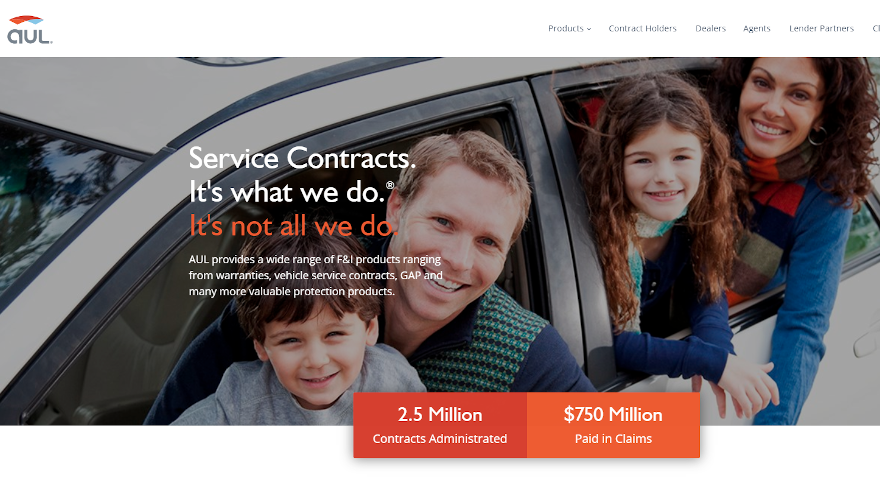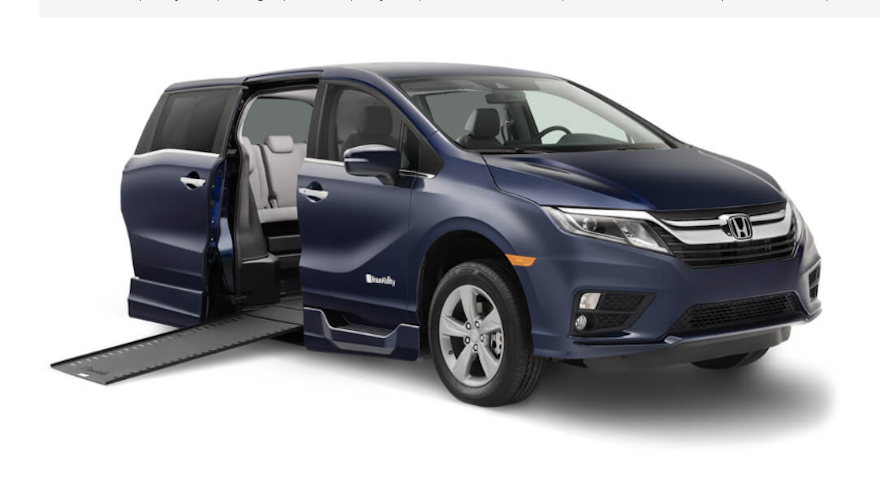AUL Corp. is aiming to keep its website as technologically advanced as the modern vehicles often covered by its F&I programs.
AUL just launched a new streamlined website following its recent addition of GAP and ancillary product offerings. AUL chief information officer Jose Fleites said in the coming months, the site will introduce an enhanced e-contracting and reporting environment designed to provide dealers and agents with a superior and seamless purchase and reporting experience.
Fleites noted these additions are part of the first phase of a multi-year revamp of the firm’s IT solutions.
“The retail automobile industry continues its transformation into an all-digital sales process, and as it does, it is imperative that we stay in front by providing agents and dealers the best tools to do their job easier, better and faster,” Fleites said in a news release.
“We are confident that our new digital solutions, and those still to come, will keep us on the leading edge of this ever-changing landscape,” he added.
Following the introduction of the new website and online tools, AUL said more developments are coming next year. The company will launch an enhanced accounting system that will further increase the accuracy and efficiency of its reporting and claims processes.
All of these changes follow last year’s introduction of Ocean, the company’s new state-of-the-art and proprietary operating system that is geared to provide the technical foundation that makes these online tools possible.
For more details, go to www.aulcorp.com.
Affordability continues to remain top-of-mind for most participants in and observers of the automotive industry. However, Experian explained consumers appear to be making due even as some industry pundits continue to be concerned that consumers can’t handle larger payments.
To reinforce its point that the data tells a different story, Experian released its Q2 2019 State of the Automotive Finance Market report on Thursday morning.
Analysts acknowledged consumers are exploring all available options to make costs more manageable, including extending contract terms and deciding between new or used vehicles.
Experian pointed out that one of the more notable ways consumers have managed to make their monthly payments more affordable is to opt for used vehicles. In fact, the report showed prime and super prime consumers financed used vehicles at record levels. Experian determined these borrowers comprised more than 57 percent of used vehicle financing during the second quarter.
“In previous years, it was common for most prime borrowers to opt for new vehicles. These vehicles tend to have better warranties and require less upfront maintenance,” said Melinda Zabritski, Experian’s senior director of automotive financial solutions.
“But with loan amounts for new and used vehicles on the rise, and a higher volume of vehicles coming off-lease, there are late-model options available that borrowers can consider,” Zabritski continued in a news release.
“It’s important for the industry to keep an eye on these trends to help inform future business decisions,” she went on to say.
Experian also mentioned the shift to used vehicles comes as the average amounts financed continue to rise.
Based on the report, the average amount financed on a new-vehicle contract came in at $32,119, while the average amount for a used-vehicle deal hit $20,156.
Additionally, the average monthly payments were $550 and $392 for new and used, respectively.
Furthermore, the report showed consumers appear to be managing payments by extending contract terms. The average loan terms for new and used vehicles reached record highs.
For new vehicles, the average term came in at 69.17 months, while the average term was 64.82 months for used vehicles. The extension of terms come as interest rates continue to remain more than 6% for new vehicles and more than 10% for used.
“There are many factors that can impact vehicles costs and car-buying decisions, but —perhaps the factor that is most critical is a car shopper’s credit score — it can impact interest rates and loan terms, which impacts monthly payments,” Zabritski said.
“Prior to heading into the dealership, car shoppers should explore ways to improve their credit standing, such as leveraging new tools and resources available to them, like Experian Boost, that can help increase their score and potentially arrange better terms,” she continued.
Despite all of the elements in play, Experian pointed out that contract holders predominantly are maintaining their monthly commitments as delinquencies remained stable in Q2.
Analysts determined 30-day delinquencies dropped to 2.11 percent, from 2.12 percent in Q2 2018, while 60-day delinquencies saw a slight increase from 0.64 percent to 0.65 percent in the same time frame.
A few other additional findings for Q2 included:
—Outstanding automotive loan balances totaled $1.197 billion.
—The percentage of outstanding loan balances held by subprime and deep-subprime consumers saw slight growth YOY (from 18.81 percent in Q2 2018 to 18.95 percent in Q2 2019) but remained below 19 percent.
—New-vehicle leasing saw a slight decrease from 30.41 percent in Q2 2019 to 30.04 percent in Q2 2019.
—Credit scores saw a two-point increase for new vehicle financing (from 715 to 717) while used saw a 1-point increase (655 to 656) year-over-year.
—The average price difference in monthly payments between loans and leases is $92.
To watch a webinar when Experian experts plan to discuss the entire Q2 2019 State of the Automotive Finance Market report, visit this website.
The latest data from Edmunds confirmed that finance companies are trying to hold firm on term, down payment and total amount financed in an effort to remain within their underwriting parameters and mitigate risk.
Edmunds’ August data did show some marginal rises in term and total amount financed year-over-year for used-vehicle and new-vehicle financing, but the average down payment did not soften tremendously.
However, analysts acknowledged the average down payment for a new vehicle dropped below $4,000 for the first time in more than a year.
Analysts determined the average interest rate for a new-vehicle retail installment contract originated in August stayed below 6% for the second month in a row. The annual percentage rate (APR) on new financed vehicles averaged 5.8% in August, compared to 5.8% in July and 6% in June.
Edmunds data revealed that the share of sales with zero percent finance deals saw a slight lift in August, constituting 6.1% of financed purchases in August compared to 5.8% in July.
“Shoppers who made it to the dealership this Labor Day weekend got to take advantage of slightly more generous offers than we’ve been seeing all year, but this shouldn’t be taken as a sign of a dramatic turnaround in the market,” Edmunds executive director of industry analysis Jessica Caldwell said in a news release.
“The model-year sell-down is still in full swing, and automakers and dealers are moving things along just like they should at this time of year,” Caldwell continued.
The summer sell-down season also coincides with hurricane season, and Edmunds analysts are keeping a close eye on how Hurricane Dorian may impact automakers. After leaving catastrophic damage in the Bahamas, the storm has been projected to scrap the coasts of Florida, Georgia and the Carolinas.
“Hurricane Dorian might have delayed some new vehicle purchases, but its overall impact on August sales appears to be fairly nominal,” Caldwell said. “We’ll be keeping a close eye to see how it may impact numbers in September as its track inches closer to the U.S. mainland.”
New-Car Finance Data
|
|
August 2019
|
August 2018
|
August 2014
|
|
Term
|
69.6
|
68.6
|
66.8
|
|
Monthly Payment
|
$556
|
$536
|
$474
|
|
Amount Financed
|
$32,590
|
$30,993
|
$27,981
|
|
APR
|
5.8
|
5.8
|
4.1
|
|
Down Payment
|
$3,991
|
$4,056
|
$3,398
|
|
Average Transaction Price
|
$37,051
|
$36,041
|
$32,027
|
Used-Car Finance Data
|
|
August 2019
|
August 2018
|
August 2014
|
|
Term
|
67.4
|
66.9
|
65.3
|
|
Monthly Payment
|
$412
|
$400
|
$374
|
|
Amount Financed
|
$22,252
|
$21,596
|
$20,322
|
|
APR
|
8.5
|
8.3
|
7.5
|
|
Down Payment
|
$2,655
|
$2,601
|
$2,241
|
Source: Edmunds
Just like the concept of the four square and first pencil helped dealership personnel explain financing details to potential buyers with paper and writing utensils, the latest solution from Darwin Automotive is using some of the same fundamentals while leveraging current technology.
This week, the F&I software provider announced the release of a next-generation tool for its users nationwide, U-Draw. During the vehicle financing process, the company explained users can now draw on, mark up and circle items on mobile devices anywhere in the world; at the dealership, at home, or from any location.
Just like using a paper menu, Darwin Automotive explained its tool can improve communication with the customer as the user can now circle payments or talking points, helping the customer quickly understand their choices and points of discussion.
U-Draw combines the best of the mobile and digital world with the feature functionality users have in the paper world, according to Darwin Automotive.
From a compliance standpoint, the company said once the user is done selling F&I products, all the drawing, underlining and circling disappear, and the consumer then signs electronically. U-Draw can be used in a multitude of different ways including home deliveries, in store, virtual F&I offerings, and online digital retailing.
“Auto dealerships use the Darwin technology platform to deliver a personalized, effective customer experience and to rate, contract and remit F&I contracts electronically,” Darwin Automotive chief executive officer Phillip Battista said in a news release.
“Our dealers have always been able to connect to customers anywhere in the world remotely,” Battista continued. “However, a technology that combines paper and digital has never before been used in F&I — this is a first.”
Darwin currently operates in all 50 states with more than 5000 dealerships nationwide enrolled in the company’s F&I software.
“We are thrilled to release U-Draw to our customer base as a value add for no cost to aid them in selling more F&I products. U-Draw will redefine the concept of paper meets digital. We aren’t just talking about the future of F&I; we are delivering in the present,” Battista went on to say.
For more information, or to schedule a product demonstration, call (732) 781-9010 or visit www.darwinautomotive.com.
Westlake Financial Services is looking to help dealership customers who have special needs when they make their next vehicle purchase while helping a business partner achieve the objective of “accessibility for all.”
This week, Westlake announced a partnership with MobilityWorks, a national wheelchair accessible van provider, to offer financing to customers looking for wheelchair accessible vehicles.
The companies said MobilityWorks will offer Westlake installment contracts through its 84 dealership locations in 24 states. Westlake added that it will finance the vehicle plus the cost of making it more wheelchair accessible at competitive loan structures with low down payment and low rate options.
“With Westlake’s extensive finance program, we are able to offer a variety of loans that fit the financial needs of customers at MobilityWorks,” said Ian Anderson, Westlake Technology Holdings Group President. “Westlake’s loans are based on the value of the vehicle plus the cost of conversion, which benefits customers in need of a van that is wheelchair accessible by offering them financing options.”
MobilityWorks vice president of business development Chris Paczak added, “Our partnership with Westlake Financial gives our customers access to financing solutions that help support the MobilityWorks mission of accessibility for all.”
Your finance company's underwriting department should be quite busy during the next few days if the newest research from WalletHub is any indication.
Despite business headlines chronicling the travails of the stock market and international trade clashes, WalletHub projected that 77.5 million new- and used-vehicle sales will be completed during Labor Day weekend with many consumers taking advantage of enhanced financing opportunities.
Furthermore, WalletHub chief executive officer Odysseas Papadimitriou stated in the site’s latest auto financing report that more than half of Americans feel more financially secure buying a car this year than last year.
“Yes, it is a good time to buy a car right now. Car loan rates are still very low, relative to historical averages. The end of the quarter typically features favorable pricing as dealers try to clear inventory and hit quotas. And car sellers need to make a big splash over Labor Day weekend because it has become such a car-buying holiday,” Papadimitriou said in the report.
“Record-breaking auto sales in recent years should also work in buyers’ favor. Sellers will have to price vehicles aggressively to keep pace with unprecedented comps,” Papadimitriou continued.
Papadimitriou also touched on whether vehicle hoppers should wait for more Federal Reserve interest rate cuts. Policymakers will take their next action at the end of September.
“Car shoppers may benefit from lower rates in the wake of future Fed rate cuts, but they could also be hurt by an escalation in the trade war. So waiting could wind up costing you money,” Papadimitriou said.
“Since no one can predict the future, the best approach is not to try to game the market. Rather, do your homework on finding a vehicle that is a good value and will fit in your budget. From a personal finance standpoint, it’s always best to focus on minimizing debt and getting all the miles you can out of your current car,” Papadimitriou went on to say.
Younger consumers are paying more for vehicle repairs than their older counterparts, according to a survey orchestrated by Ally Financial, which also reinforced the value of vehicle service contracts.
A recent Ally survey conducted online by The Harris Poll among 2,012 U.S. adults determined that, on average, Americans spent $1,986 on vehicle repairs and maintenance during the last five years.
Millennials and Generation Z (individuals ages 18-34 for this survey) paid an average of $2,334 for vehicle maintenance and repairs in the past five years — a significantly higher financial burden than baby boomers and older adults.
In comparison, the survey indicated adults 55 and older spent $1,654, on average, during the same timeframe.
Ally’s survey results come on the heels of research from the Federal Reserve that found that nearly 4 in 10 adults would not be able to cover unexpected expenses of $400 without selling something or going into debt.
“Many Americans rely on their cars to get to work and losing access to your vehicle can be a major disruption and huge source of stress — particularly if you can’t cover the repair cost,” said Mark Manzo, president of insurance at Ally Financial.
“The financial strain can be even more daunting for young people who are early in their careers and may be paying down student loan debt as well,” Manzo continued.
And when it comes to savings, younger adults are at a disadvantage. Another recent Ally survey found that two-thirds of 18- to 24-year-olds have not established any type of emergency savings fund, compared to approximately half of all other adults.
Ally’s latest survey findings uncovered significant differences in expenses by age and family size, suggesting that not all Americans share in repair costs evenly:
Younger people paid nearly $700 more in car repairs and maintenance, on average, than Americans aged 55 and older during the last five years. The survey found that, on average, U.S. adults:
— 18-34 spent $2,334
— 35-44 spent $1,978
— 45-54 spent $2,135
— 55 and older spent $1,654
On average, households with children under 18 paid $347 more in car repairs and maintenance over the past five years than households without children ($2,201 versus $1,854), suggesting that the expense of raising a family may be compounded by additional repair and maintenance costs.
“Unfortunately, there are too many Americans who are just one unexpected repair bill away from being forced to make tough financial decisions,” Manzo said. “What’s more, many of these drivers aren’t aware of options, like vehicle service contacts, to make their repair costs more predictable.”
The Ally survey also found that only 21% of Americans have purchased a vehicle service contract (VSC) or extended warranty in the last five years. VSCs are protection products that can cover expenses such as repairs and replacement parts.
Ally Premier Protection vehicle service contracts can cover more than 7,500 vehicle components and offer additional benefits including rental reimbursement, roadside assistance and reimbursement for trip interruption caused by a breakdown. Levels of coverage vary by plan.
“Additionally, VSCs can be used to manage repair costs over an extended period of time, making these expenses more predictable and easier to fit into a household budget,” Ally reiterated.
Coming off of what the president and chief executive officer described as a “transitional year,” Nicholas Financial opened its 2020 fiscal year with positive net income after finishing its 2019 fiscal year with a loss.
The publicly-traded specialty consumer finance company operating branch locations in both the Southeast and Midwest, recently announced its net income for the three months that ended June 30 came in at $0.6 million. Nicholas Financial generated that figure even though revenue decreased 11.3% to $16.6 million.
Still, the metrics are an improvement from the close of its 2019 fiscal year that included a net loss for the entire reporting period of $3.6 million.
“We are pleased to be able to report positive earnings in our first quarter,” Nicholas Financial president and CEO Doug Marohn said in a news release. “Although it is only one quarter, the results indicate that the strategy and tactics deployed during fiscal 2019 are starting to pay dividends in fiscal 2020.
“Our core operations were profitable independent of the Metrolina acquisition, and that acquisition definitely helped to increase our realized net earnings for the quarter,” Marohn continued.
Back at the end of April, Nicholas Financial announced that the company acquired substantially all of the assets of ML Credit Group, which does business as Metrolina Credit Co. and provides financing to consumers by direct loans and through purchases of retail installment sales contracts originated by dealers in North Carolina and South Carolina.
“We are very pleased to announce the company’s acquisition of Metrolina. Metrolina’s local focus in North Carolina and South Carolina nicely complements our existing automobile financing program,” Marohn said at the time of the acquisition.
“Having been the CEO of Metrolina Credit Company for four years from 2014 through 2017, I am very versed in their operations, personnel and culture. We are excited to be consolidating our two companies that are so well aligned in many aspects,” continued Marohn, who noted that the transaction brought scale to its existing operations in the Carolinas by adding more than 3,000 accounts and more than $22 million in net receivables.
Turning back to the Q1 results, Marohn emphasized the strategy changes Nicholas Financial has implemented. Marohn previously explained that the company returned to a 120-day charge off policy that includes Chapter 13 bankrupt accounts, “which is more in line with industry standard.” The company also trimmed its market footprint by closing branch locations in Texas and Virginia.
And the results?
“More importantly, our portfolio metrics continue to improve and will be the driving force behind future earnings,” Marohn said. “We continue to book loans with higher rate, increased discount, lesser advance and shortened term. Our return to disciplined underwriting has had a positive impact on our portfolio yield as our gross portfolio yield has increased to 28.3% compared to 25.3% in the prior year first quarter.
“The return to a 120-day charge-off policy along with adjustments to our servicing approach has resulted in improved performance, too,” he continued. “Our 30-day delinquency is down approximately 100 basis points with most of that coming from a reduction in the 60 days past due category.”
Furthermore, Nicholas Financial reported that it’s gaining traction beyond the paper its buying from its network of dealerships.
“We are also starting to see our direct loan product contributing to our top and bottom lines. Our direct loan portfolio has now grown to over $8 million and performs better than our indirect portfolio in terms of delinquency and losses,” Marohn said.
Currently Nicholas Financial offers direct loans in Florida, Georgia, North Carolina and Ohio, and the company is in the process of obtaining licenses in the remaining states where it operates.
“As of July, we obtained licensing in Tennessee, and we intend to initiate direct consumer lending there during the second quarter of fiscal 2020. Several other states are in the final stages of licensing and we intend to have all states licensed and operational this calendar year,” Marohn added.
With potential buyers walking into the dealerships with smartphones and the ability to find information, DealerPeak’s Desk Max is looking to equip store personnel with a tablet-driven tool to generate vital data stemming from soft credit pulls, potential monthly payment details and more.
DealerPeak recently enhanced its tool to users to log-in customers, add vehicles of interest and complete the trade-in process with three simple scans. Additionally, users can desk deals, pull credit, amend deal structure, pull credit, and start the deal process directly from the lot.
DealerPeak chief product officer Rick McLey designed and developed the platform. DealerPeak debuted in 1999 with a primary task to support a 17-location automotive franchise that was rapidly expanding. Over the past few years, DealerPeak has been focusing on developing mobile-first technology, to create practical solutions several of their consumers have been seeking.
The Desk Max mobile desking solution is powered by strategic partnerships with companies including 700Credit, which permits the user to access their soft-pull technology to begin the sales process. Additional partnerships with Dealertrack, Automate DMS Deal Push, Autosoft, CDK Global, Reynolds & Reynolds and others also are involved in DMS integration.
Each of these tools built into Desk Max can return all rebates and rates for purchases and lease deal structures. It can check rebates for compatibility to ensure little to no rebate chargebacks. The infusion of these tools can permit dealers to create the best deals for themselves and the customers out of the gate.
“Most car dealer CRM’s offer a watered-down desking solution – that’s not good enough for our valued clients,” McLey said.
“DealerPeak has leveraged our mobile-first technology to create a tablet and mobile desking solution that completely automates the deal,” he continued. “This type of flexibility gives dealerships the ability to roll payment options, change banks, amend terms and review all rebates from their tablet or mobile device. It also automatically checks compatibility to minimize the potential of rebate chargebacks
“Our ultimate goal was to develop mobile first CRM solutions for car dealerships that will enhance the customer buying experience,” McLey added. “With complete DMS integration, the ability to process new car lease and purchases, include city, county, and state tax structures, and print all documents directly from the lot, along with complete device integration, we’ve created a robust and complete car dealership CRM solution.
“We’re excited to offer this mobile-first desking technology in each of our DealerPeak Evolution solutions,” he went on to say.
The DealerPeak mobile-first technology powers each of its CRM solutions including CarDog.com, DealerPeakPlus.com and its new DealerPeak Classic platform. Each is custom designed for different sized dealerships. All DealerPeak solutions are supported by a team of technical experts that have extensive dealership experience.
“Their practical car dealership knowledge combined with technical expertise allows them to provide real-world solutions that are easy to follow and comprehend,” the company said.
To learn more about DealerPeak’s desktop and mobile desking tool, Desk Max, visit this website.
Perhaps it’s just happenstance that Edmunds spotted the average interest rate for new-vehicle financing softening to its lowest level of the year in the same timeframe as the Federal Reserve making its first interest-rate cut in 11 years.
Edmunds reported on Thursday that the average APR on new models financed during July declined for the third month in a row to settle at the lowest point so far this year at 5.84%. That’s down from 6% in June but up from 5.75% in July of last year.
Edmunds data showed that 35% of shoppers who financed their new-vehicle purchases in July got an interest rate below 4%, compared to 31% of those who financed purchases in June.
For used vehicles, Edmunds determined the average APR came in at 8.6% in July, nearly steady compared to the previous month (8.58%) but 30 basis points above the year-ago reading (8.3%).
“Rising vehicle costs and high-interest rates have been placing immense pressure on the new-car market all year, so it’s nice to see shoppers get a bit of a reprieve,” Edmunds executive director of insights Jessica Caldwell said in a news release.
“Consumers are still in for a bit of sticker shock if they’re coming back to the market for the first time in a few years, but the fact that interest rates are trending slightly lower is helping soften the blow,” Caldwell said.
The valuation analysts at Kelley Blue Book reported the estimated average transaction price for a new light vehicle in the United States came in $37,169 in July. New-model prices increased $1,246 or 3.5% from July of last year, while decreasing $312 or 0.8% from the previous month.
“While July is expected to come in below a 17-million SAAR pace, the industry average transaction price continued its steady rise, up 3% year-over-year,” Kelley Blue Book analyst Tim Fleming said. “Trucks were the big story in July as new mid-size and full-size offerings helped to drive truck prices up about 3% while contributing to sales growth in this down market.
“With the new 1500 trucks from RAM and GM that came out last year, full-size truck prices have now eclipsed the $50,000 mark, and new heavy-duty trucks from these manufacturers this year will push those numbers up even more,” Fleming went on to say.
No doubt even with a hefty down payment and modest terms, the monthly payment included in that retail installment sales contract is still likely to be a sizeable amount. Cox Automotive chief economist Jonathan Smoke isn’t too bullish about the Fed’s rate cut opening the financial floodgates for a major growth in finance company portfolios.
“We believe retail new-vehicle sales are not likely to improve this year even with moderately lower rates. Even if auto-loan rates were to come down marginally, the prospective new-vehicle buyer is still contending with the most expensive vehicles ever sold,” Smoke wrote in this blog post.
“It is likely the only way we’ll see retail demand for new vehicles strengthen substantially this year is if we see more rate subvention by the captive finance companies and higher incentives that materially lower payments,” he continued.
“It’s tough to predict where consumer rates will be, but given the Fed shifting policy stance from tightening to easing, the best bet is auto-loan rates will be stable to modestly lower. It takes out the risk of higher rates and therefore removes any sense of urgency to buy sooner than later,” Smoke went on to say.
Turning back to the team at Edmunds, Caldwell noted that one reason average interest rates have dipped is due to automakers and dealers sweetening deals in an effort to clear out lingering 2018 models. Edmunds estimated 3% of new vehicles sold in July were 2018 models, the highest level of outgoing model-year sales of any July in Edmunds’ records, dating back to 2002.
“The fact that there are still 2018 models sitting on dealer lots this far into the year is pretty disconcerting, but at least we’re seeing that automakers and dealers are making a greater effort to get shoppers in the door,” Caldwell said.
Looking ahead, Edmunds analysts projected automakers will likely continue to offer subtle interest-rate incentives over the next few months as the summer sell-down season continues, but dramatic cuts aren’t likely.
Caldwell also noted that the Fed rate cut won’t make much of a real difference to consumers’ wallets either.
“People might hear this news and think this means buying a car just got a lot cheaper, but in reality shoppers aren't going to see much of a difference in their car payment from a quarter percent rate cut,” Caldwell said.
“Even with this move and automaker incentives, we expect to see average interest rates lingering in the 5% territory through the rest of the year,” she went on to say.
New-Car Finance Data
|
|
July 2019
|
July 2018
|
July 2014
|
|
Term
|
69.6
|
68.8
|
67.0
|
|
Monthly Payment
|
$556
|
$534
|
$473
|
|
Amount Financed
|
$32,625
|
$30,914
|
$28,022
|
|
APR
|
5.84
|
5.75
|
4.09
|
|
Down Payment
|
$4,032
|
$4,007
|
$3,280
|
|
Average Transaction Price
|
$37,030
|
$35,565
|
$32,211
|
Used-Car Finance Data
|
|
July 2019
|
July 2018
|
July 2014
|
|
Term
|
67.5
|
67.0
|
65.4
|
|
Monthly Payment
|
$412
|
$398
|
$374
|
|
Amount Financed
|
$22,256
|
$21,574
|
$20,369
|
|
APR
|
8.6
|
8.3
|
7.5
|
|
Down Payment
|
$2,603
|
$2,582
|
$2,219
|
Source: Edmunds












